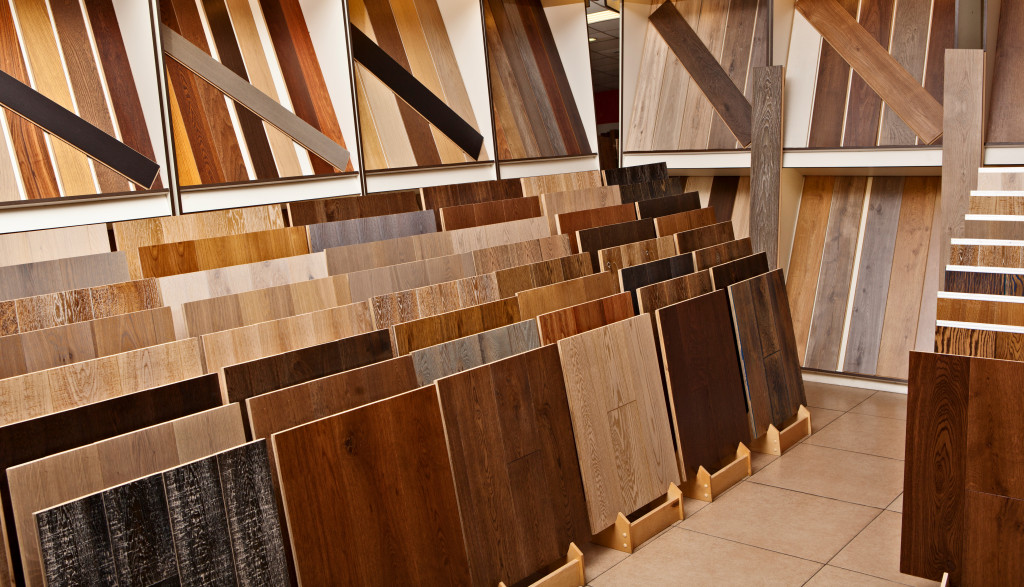The floor can set the tone of your home. It can make your house feel opulent, inviting, professional, or friendly and casual. Choosing the type of flooring for your home isn’t a decision to be made rashly. There are different types of flooring, each one with its own advantages and disadvantages.
Wood
By far, the most popular choice for flooring is still wood. Traditional wooden flooring is popular due to its aesthetics, convenience, and cost. Wooden floors make a house appear warmer and more like a home than anything else. Houses with wooden floors command higher prices when sold and are very much in demand in the market. Timber or traditional hardwood is often used.
However, engineered wood is also becoming a popular option. Engineered wood is constructed from multiple layers of wood. They are layered with their grains in a cross-like pattern, making them less prone to warping and swelling. Engineered wood can cost half that of actual hardwood, but it retains the appearance and resiliency of actual wood.
Both hardwood floors and engineered wood floors can last 30 years or more. Wood can get damaged by contact or scrapes from harder objects, so make sure you wipe your shoes before going inside the house. Get a proper outdoor mat from a shop or buy one online and make sure the kids know what to do before entering the house.
Concrete
Polished concrete floors are quite popular in modern and more affluent homes, particularly in living rooms and kitchens. The seamlessness of polished concrete floors exudes opulence and efficiency, but they might seem uninviting and cold. Concrete floors can last for decades and require little to no maintenance.
A broom or a mop can easily clean up any mess, and there are no grouts or seams for dirt to seep into. It would take a lot to damage a concrete floor, but repairs can still be done quite easily. Polished concrete floors are both waterproof and fireproof. They work well with predominantly stone houses, particularly ones that use lighting to add to their aesthetics.
One downside to concrete floors is they may be prone to fading when exposed to constant ultraviolet radiation. Sunlight can ruin the color of your floors in five to ten years, so make sure your floors have proper protection. Install UV-filtering film on your windows to let sunlight in but keep harmful UV out. You’ll be protecting your floors from discoloration and your family from skin cancer and melanomas.
Tiles

Ceramic tiles are durable and easy to clean. They come in a variety of shapes, sizes, and appearance. They can be any color you want or even take the appearance of wood. Like concrete floors, tiles are both waterproof and fireproof. Ceramic tiles are hardier than wood, but they can still get damaged by sudden impacts.
You can buy a few replacement tiles for the occasion. They require very little maintenance as long as tile grouts are properly sealed. Tile grouts typically last ten years before needing replacement, as long as your pets don’t scrape away at their surfaces. Ceramic tiles are also vulnerable to discoloration when exposed to UV. Tiles can be slippery when wet, so most households limit them to the kitchen and the bathrooms.
Vinyl
The cheapest flooring option is vinyl. It comes in whole sheets or individual tiles. Vinyl is best used in level flat surfaces and requires adhesive to stick to the floor. Once properly installed, vinyl floors are easy to clean and quite resistant to damage. If you opt for tiles, go for ones with over 8 mm thickness for more durability. Vinyl is easy to install and remove.
Unfortunately, the use of adhesives makes vinyl floors quite vulnerable to water damage. A flood or a nasty spill can leave your vinyl tiles popping from the floor. Homes with vinyl floors can take a drop in their property value. Buyers will often find them cheap and are more likely to bid lower than the actual asking price.
Mixing and Matching
You are not limited to one flooring option for your entire home. Most Australian homes have several types of flooring, sometimes different ones for every room. Note the uses of each room and what kind of flooring fits aesthetically and practically, and make your choices from there.
Different types of floors serve different purposes. Floors can be aesthetic and practical, and you can tailor each room of your house with the floor that matches it. So consider the various factors before deciding which type you should use.






